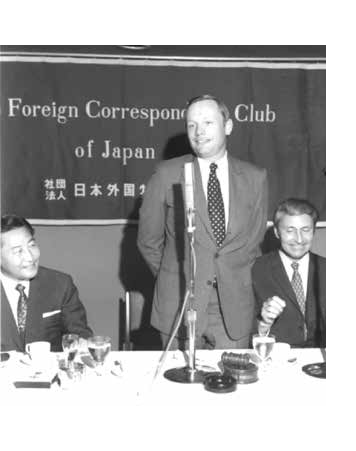Issue:
TOURISM BY THE NUMBERS
The number of international visitors to Japan in 2015
19.73m
47.3%
Estimated number of international visitors to Japan in January 2016
1.85m
52%
Estimated number of Chinese visitors to Japan in January 2016
475,000
110%
66.37
505.45
Figures for 2015 in millions
The number of nights spent in Japan by foreign tourists
as a fraction of
the number of nights spent in hotels and inns by all tourists
17.7
Figure for 2015 in millions
The number of nights spent in Tokyo by foreign tourists
Comparison of hotel occupancy rates in Osaka Prefecture and Tokyo

85.2%

82.3%
¥3,480, 000, 000, 000
Spending by foreign visitors to Japan in 2015
71%
¥32,100, 000, 000
2014 duty-free revenue of the 27 airports run by the central government
Sources: Nikkei Asian Review, Asahi Shimbun, Japan Tourism Marketing Co., the Japan Times
THE EAGLE HAS LANDED

“That's one small step for [a] man, one giant leap for mankind,” were the unforgettable words uttered by Neil Armstrong as he stepped onto the moon’s surface on July 21, 1969. He recounted that moment at our Club on Aug. 9, 1971, and no doubt faced questions about the inaudible article “a” before “man,” which NASA's transcript continues to show in brackets. Then president of the FCCJ, Pierre Brisard (AFP) is seated to his left; to his right is Bill Shinn (Sisa News Agency), who was a key negotiator in our move to the Yurakucho Denki Building in 1976 and Club president in 1976-77.
Neil Armstrong was born in Ohio on Aug. 5, 1930. As a U.S. Navy pilot, he flew 78 missions during the Korean War, and went on to become a test pilot, aerospace engineer and astronaut.
It was on Armstrong’s second and last space flight, as commander of Apollo 11, the first manned mission to the moon in July 1969, that he and Buzz Aldrin walked on the moon. They spent two-and-a-half hours outside the spacecraft while colleague Michael Collins remained in lunar orbit. All three were highly honored with numerous awards after their safe return to Earth.
Armstrong retired from NASA in 1971, after which he became an educator and business spokesman. His visit to Japan and to the FCCJ came a bit more than two years after his walk on the moon and soon after his retirement.
Unlike several other former astronauts who went into politics, with John Glenn being the best known, Armstrong spurned overtures from the major political parties. However, he reportedly favored states’ rights and frowned upon the U.S. becoming the “world’s policeman.”
He died on Aug. 25, 2012 at the age of 82, as a result of complications following coronary artery bypass surgery. A quote from his family sums up the man: “For those who may ask what they can do to honor Neil, we have a simple request. Honor his example of service, accomplishment and modesty, and the next time you walk outside on a clear night and see the moon smiling down at you, think of Neil Armstrong and give him a wink.”
[On a personal note, an overseas trip prevented me from attending the professional luncheon for Armstrong, something I truly regret. I felt a certain kinship, since I had flown with pilots like him during my years as an aircrew member in the U.S. Navy (1947-1956). My Korean War experiences, although not comparable with Armstrong’s as a fighter pilot, had us flying over much the same terrain during my 79 missions as a radioman, radar operator, and aerial gunner.]

